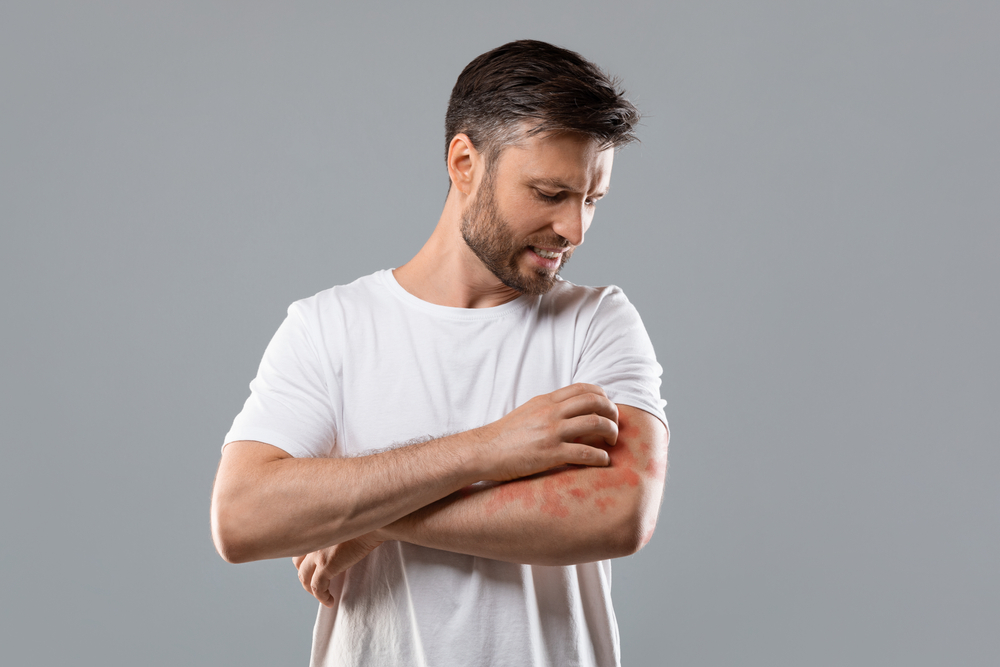Dermatitis is a common skin condition that affects millions of people worldwide. It is characterized by inflammation of the skin, resulting in redness, itching, and sometimes blistering or cracking. Dermatitis can be caused by a variety of factors, including allergies, irritants, and genetic predisposition. This article aims to provide a comprehensive overview of dermatitis, including its types, symptoms, and treatment options.
Types of Dermatitis
There are several types of dermatitis, each with its own distinct characteristics. The most common types include atopic dermatitis, contact dermatitis, and seborrheic dermatitis.
Atopic dermatitis, also known as eczema, is a chronic condition that usually begins in infancy or childhood. It is characterized by dry, itchy, and scaly skin, which can become red and inflamed. Atopic dermatitis often occurs in individuals with a family history of allergies or asthma.
Contact dermatitis occurs when the skin comes into direct contact with an irritant or allergen. It can be further divided into two types: irritant contact dermatitis and allergic contact dermatitis. Irritant contact dermatitis is caused by exposure to substances such as chemicals, soaps, or detergents, which damage the skin’s protective barrier. Allergic contact dermatitis, on the other hand, is a delayed hypersensitivity reaction to a specific allergen, such as nickel, latex, or certain plants.
Seborrheic dermatitis primarily affects the scalp, face, and chest. It is characterized by red, scaly patches that may be itchy or uncomfortable. Seborrheic dermatitis is commonly associated with excessive oil production and the presence of a yeast called Malassezia on the skin.
Symptoms of Dermatitis
The symptoms of dermatitis vary depending on the type and severity of the condition. However, common symptoms include redness, itching, swelling, and dryness of the skin. In some cases, dermatitis can lead to the formation of blisters or crusts, which may cause pain or discomfort.
Individuals with atopic dermatitis often experience episodes of intense itching, which can disrupt sleep and daily activities. The skin may also become thickened or leathery in appearance, especially in chronic cases.
Contact dermatitis typically presents as a localized rash at the site of contact with the irritant or allergen. The affected area may be red, swollen, and itchy. In severe cases, blisters or open sores may develop.
Seborrheic dermatitis commonly affects the scalp, resulting in dandruff-like flakes and itching. It can also affect the face, causing redness and scaling, particularly in the eyebrows, nasal folds, and behind the ears.
How to Treat Dermatitis
The treatment of dermatitis depends on the type and severity of the condition. In general, the primary goals of treatment are to reduce inflammation, relieve itching, and restore the skin’s barrier function.
For mild cases of dermatitis, over-the-counter creams or ointments containing hydrocortisone or antihistamines may be sufficient to alleviate symptoms. These medications help to reduce inflammation and itching. It is important to follow the instructions provided and avoid prolonged use, as they can cause side effects.
In more severe cases, prescription-strength topical corticosteroids may be necessary. These medications are stronger and can effectively reduce inflammation. However, they should be used under the guidance of a healthcare professional, as prolonged or excessive use can lead to skin thinning or other complications.
In addition to topical treatments, individuals with dermatitis may benefit from certain lifestyle modifications. It is essential to avoid triggers or irritants that can exacerbate symptoms. This may involve using gentle, fragrance-free skincare products, avoiding allergens or irritants, and maintaining good overall skin hygiene.
Dermatitis is a common skin condition that can significantly impact an individual’s quality of life. Understanding the different types of dermatitis, recognizing the symptoms, and seeking appropriate treatment are crucial for effective management. While there is no cure for dermatitis, various treatment options are available to alleviate symptoms and maintain healthy skin. It is important to consult with a healthcare professional for an accurate diagnosis and personalized treatment plan. By following proper skincare practices and avoiding triggers, individuals with dermatitis can successfully manage their condition and minimize its impact on their daily lives.


